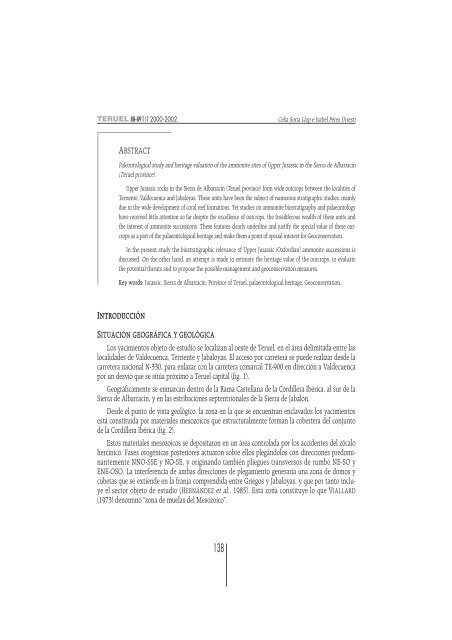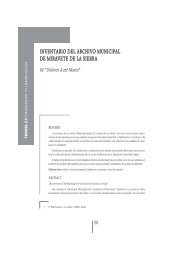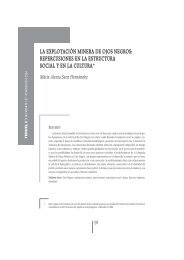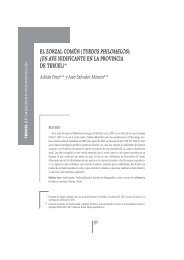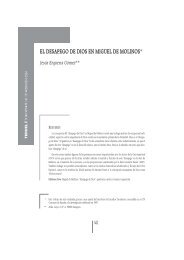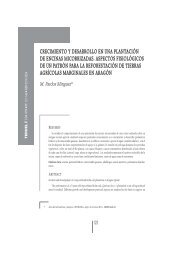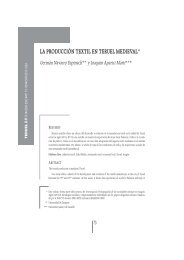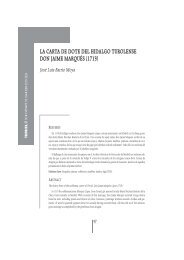estudio paleontológico y valoración patrimonial de los yacimientos ...
estudio paleontológico y valoración patrimonial de los yacimientos ...
estudio paleontológico y valoración patrimonial de los yacimientos ...
You also want an ePaper? Increase the reach of your titles
YUMPU automatically turns print PDFs into web optimized ePapers that Google loves.
88-89 [ I ] 2000-2002 Celia Soria Llop e Isabel Pérez Urresti<br />
ABSTRACT<br />
Paleontological study and heritage valuation of the ammonite sites of Upper Jurassic in the Sierra <strong>de</strong> Albarracín<br />
(Teruel province).<br />
Upper Jurassic rocks in the Sierra <strong>de</strong> Albarracín (Teruel province) form wi<strong>de</strong> outcrops between the localities of<br />
Terriente, Val<strong>de</strong>cuenca and Jabaloyas. These units have been the subject of numerous stratigraphic studies, mainly<br />
due to the wi<strong>de</strong> <strong>de</strong>velopment of coral reef formations. Yet studies on ammonite biostratigraphy and palaeontology<br />
have received little attention so far <strong>de</strong>spite the excellence of outcrops, the fossiliferous wealth of these units and<br />
the interest of ammonite successions. These features clearly un<strong>de</strong>rline and justify the special value of these outcrops<br />
as a part of the palaeontological heritage and make them a point of special interest for Geoconservation.<br />
In the present study the biostratigraphic relevance of Upper Jurassic (Oxfordian) ammonite successions is<br />
discussed. On the other hand, an attempt is ma<strong>de</strong> to estimate the heritage value of the outcrops, to evaluate<br />
the potential threats and to propose the possible management and geoconservation measures.<br />
Key words: Jurassic, Sierra <strong>de</strong> Albarracín, Province of Teruel, palaeontological heritage, Geoconservation.<br />
INTRODUCCIÓN<br />
SITUACIÓN GEOGRÁFICA Y GEOLÓGICA<br />
Los <strong>yacimientos</strong> objeto <strong>de</strong> <strong>estudio</strong> se localizan al oeste <strong>de</strong> Teruel, en el área <strong>de</strong>limitada entre las<br />
localida<strong>de</strong>s <strong>de</strong> Val<strong>de</strong>cuenca, Terriente y Jabaloyas. El acceso por carretera se pue<strong>de</strong> realizar <strong>de</strong>s<strong>de</strong> la<br />
carretera nacional N-330, para enlazar con la carretera comarcal TE-900 en dirección a Val<strong>de</strong>cuenca<br />
por un <strong>de</strong>svío que se sitúa próximo a Teruel capital (fig. 1).<br />
Geográficamente se enmarcan <strong>de</strong>ntro <strong>de</strong> la Rama Castellana <strong>de</strong> la Cordillera Ibérica, al sur <strong>de</strong> la<br />
Sierra <strong>de</strong> Albarracín, y en las estribaciones septentrionales <strong>de</strong> la Sierra <strong>de</strong> Jabalón.<br />
Des<strong>de</strong> el punto <strong>de</strong> vista geológico, la zona en la que se encuentran enclavados <strong>los</strong> <strong>yacimientos</strong><br />
está constituida por materiales mesozoicos que estructuralmente forman la cobertera <strong>de</strong>l conjunto<br />
<strong>de</strong> la Cordillera Ibérica (fig. 2).<br />
Estos materiales mesozoicos se <strong>de</strong>positaron en un área controlada por <strong>los</strong> acci<strong>de</strong>ntes <strong>de</strong>l zócalo<br />
hercínico. Fases orogénicas posteriores actuaron sobre el<strong>los</strong> plegándo<strong>los</strong> con direcciones predominantemente<br />
NNO-SSE y NO-SE, y originando también pliegues transversos <strong>de</strong> rumbo NE-SO y<br />
ENE-OSO. La interferencia <strong>de</strong> ambas direcciones <strong>de</strong> plegamiento generaría una zona <strong>de</strong> domos y<br />
cubetas que se extien<strong>de</strong> en la franja comprendida entre Griegos y Jabaloyas, y que por tanto incluye<br />
el sector objeto <strong>de</strong> <strong>estudio</strong> (HERNÁNDEZ et al., 1985). Esta zona constituye lo que VIALLARD<br />
(1973) <strong>de</strong>nominó “zona <strong>de</strong> muelas <strong>de</strong>l Mesozoico”.<br />
138


